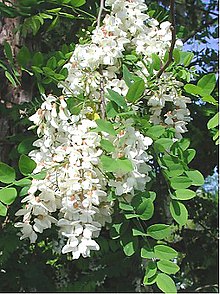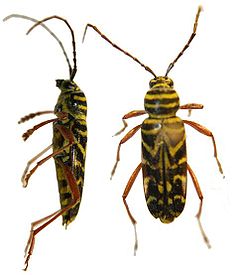I've not done a phenology post for a while. Today, however, I saw something I don't see every year: Robinia pseudoacacia in bloom.
I walked the long way around town to the computer center, which always means more opportunities to see more wild flowers, and saw plenty: violets, buttercups, fleabane "daisies," a few early "oxeye" daisies, wild geraniums, a few Bidens, ground-ivy, celandine, blackberry blossoms, the first few blooms of bedstraw. And a mourningdove.
Back at the Cat Sanctuary, my white roses started to bloom yesterday, and my oldfashioned yellow iris put forth its first bloom this morning. This iris colony really is "old," at least 55 or 60 years old. Blooms usually grow 20-30 inches above the ground. Since the "Tall" blue iris was planted on the other side of the house, however, the yellow one seems to have gone into competition (or cross-pollination?). One year one bloom got up to 49 inches, and this year's first bloom was close to 36 inches above the ground.
My grandmothers loved this iris, and so do I. One year I swear it waited until July, when I'd stayed in Washington through June, to bloom when I came home. Aside from the illusion of a relationship with this particular planting, I think what I like about the iris is the fact that this big, fragrant, showy flower positively requires minimal care and poor soil.
But what would have pleased my father, if he could have seen it, was the black locust tree, with the cardinal perched in it.
(Black locust blossom image shared by Pollinator at https://en.wikipedia.org/wiki/File:Robina9146.JPG .)

The locust tree, Robinia pseudoacacia, is a legume. Big as it is (up to 70 feet high), it's closely related to garden peas and peanuts, and has similar leaves. It also has similar roots, and helps to aerate and "revitalize" overworked soil.
When I was a child and most people actively farmed at least part of their land, fields allowed to lie fallow would usually produce a few black locust trees. My brother and I enjoyed watching them sprout up. New growth is smooth, with thin bark protected by sharp brittle thorns, which we used to rub off between our fingers. As the trees mature, woodier parts develop thicker, more typical "tree"-type bark.
Mature trees produce fragrant white blooms. (Wikipedia says a yellow mutation is possible.)
Black locusts are not closely related enough to hybridize with honey locust or carob trees; nevertheless, bees make honey from the blooms, and humans can eat the flowers (usually by cooking and sweetening the petals). The leaves, bark, and seeds may be mildly poisonous to equines and humans; the phytochemical usually blamed for any toxicity is destroyed by heating, but no, this tree is not carob, and it never will be. The tree coexists splendidly with many other things that are native to, even emblematic of, our corner of Virginia.
Locust wood is surprisingly hard and durable when well seasoned. It is not often found in the best condition. It makes dangerous firewood in any condition--if dry enough to burn at all, it will burn hotter than other wood and shoot out more sparks. Fresh-cut locust wood has a strong, sweet odor that few people want to live with. However, once dried out, it's considered good timber for building things that will be exposed to weather. Wesley Greene calls it "the tree that shaped the United States" and quotes an early historian who says it was used for making hunting bows.
So, if the young trees are good for the soil, the blossoms have some use as food, and the wood can be good timber, why doesn't everybody cultivate black locust trees? Because they don't cultivate well. When my father was growing up, black locust trees flourished--briefly--in our corner of Virginia, as a first-growth species on clear-cut land. During my childhood, the locust borers discovered them and moved back in, and the trees began dying out. It didn't take the local population long to achieve local extinction. We'd see hillsides with a dozen or so rotting, dying locust trees in a cow pasture, and Dad would mourn, fearing that the species would go completely extinct due to insect-predator loss and other complications of the Vicious Spray Cycle.
During the years when he knew he was going blind, but could still see trees, Dad looked for locust trees and didn't see them. I think it did him some good, after he'd become blind, to hear that I'd found black locust trees blooming in a park in Maryland. For a minute or two his face brightened. Then he said, "But they'll get infested and die out there, too."
They usually do. Black locust trees grow fast enough, and reproduce fast enough, to survive in a precarious balance with their primary predator species--the borers. Here and there people find mature trees with healthy wood...but the species never forms real groves or forests. The blooms attract locust borers, which both eat the wood and spread a fungus that kills the trees, and the trees start to die out.
(Locust borer image shared by Cody Hough at https://en.wikipedia.org/wiki/File:M_robiniae.jpg . In real life these beetles are half an inch to three-quarters of an inch long; males have longer antennae than females. They mimic bees but can't sting. They are remarkably resistant to most insecticides...don't start a Vicious Spray Cycle; black locusts and locust borers are precariously balanced at best.)

Black locust trees have spread, usually by deliberate cultivation, into the Northern States and Europe. It's not taken long for the borers to follow the trees, so although these trees may be invasive, they will probably never manage to become a nuisance species. If you see one, and they're not native to the place where you see it, enjoy this tree while you can.

No comments:
Post a Comment